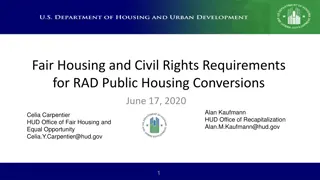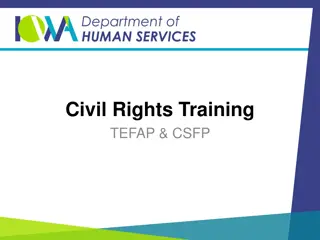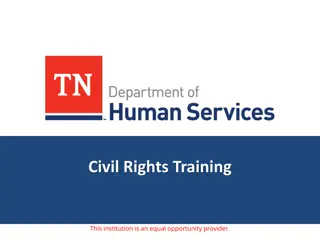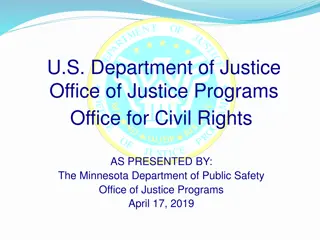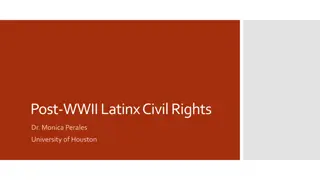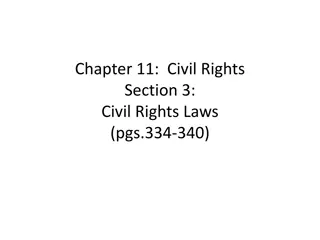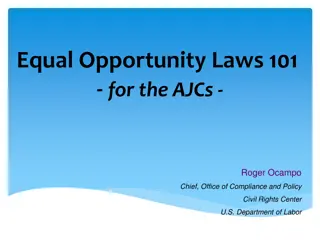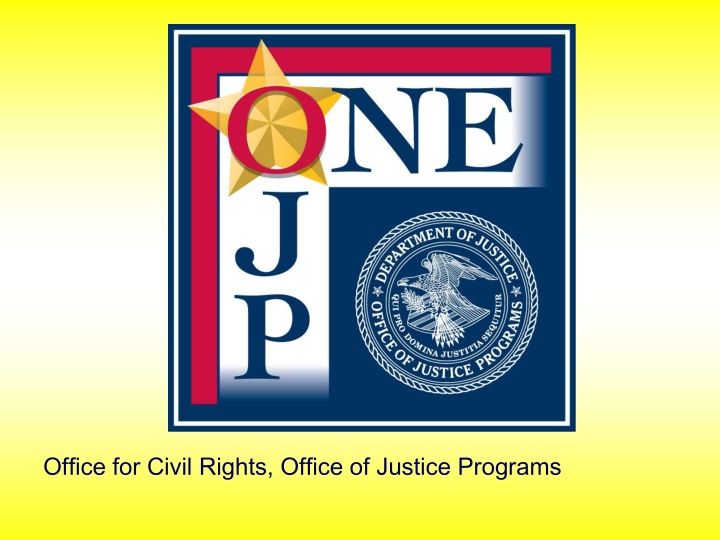
Office for Civil Rights and Justice Programs
The Office for Civil Rights enforces various civil rights statutes and programs to ensure nondiscrimination and equal access to benefits and services based on race, color, national origin, sex, religion, disability, sexual orientation, gender identity, age, and more.
Download Presentation

Please find below an Image/Link to download the presentation.
The content on the website is provided AS IS for your information and personal use only. It may not be sold, licensed, or shared on other websites without obtaining consent from the author. If you encounter any issues during the download, it is possible that the publisher has removed the file from their server.
You are allowed to download the files provided on this website for personal or commercial use, subject to the condition that they are used lawfully. All files are the property of their respective owners.
The content on the website is provided AS IS for your information and personal use only. It may not be sold, licensed, or shared on other websites without obtaining consent from the author.
E N D
Presentation Transcript
Civil Rights Obligation s $
The Office for Civil Rights Enforces Title VI of the Civil Rights Act of 1964 (race, color, national origin) Program Statutes (e.g., Safe Streets Act, Victims of Crime Act, Violence Against Women Act, JJDPA) (race, color, national origin, sex, religion, disability, sexual orientation, gender identity) Section 504 of the Rehabilitation Act of 1973 (disability) Title II of the Americans with Disabilities Act of 1990 (disability) Age Discrimination Act of 1975 (age) Title IX of the Education Amendments of 1972 (sex in education programs)
Victims of Crime Act Nondiscrimination Provision No person shall on the ground of race, color, religion, national origin, handicap, or sex be excluded from participation in, denied the benefits of, subjected to discrimination under, or denied employment in connection with, any undertaking funded in whole or in part with sums made available under this chapter. 34 U.S.C. 20110(e).
Violence Against Women Act Reauthorization Act of 2013 No person in the United States shall, on the basis of actual or perceived race, color, religion, national origin, sex, gender identity, (as defined in paragraph 249 (c)(4) of title 18, United States Code), sexual orientation, or disability be excluded from participation in, be denied the benefits of, or be subjected to dis- crimination under any program or activity funded in whole or in part with funds appropriated for grants, cooperative agreements, and other assistance administered by the Office on Violence Against Women.
Violence Against Women Act Reauthorization Act of 2013 cont. If sex segregation or sex-specific programming is necessary to the essential operation of a program, nothing in this paragraph shall prevent any such program or activity from consideration of an individual s sex. In such circumstances, grantees may meet the requirements of this paragraph my providing comparable services to individuals who cannot be provided with the sex-segregated or sex-specific programming. 34 U.S.C. 12291(b)(13) OCR has posted FAQs on the VAWA nondiscrimination provision at https://ojp.gov/about/ocr/pdfs/vawafaqs/pdf
Violence Against Women Act Reauthorization Act of 2013 cont. Sex-Segregated Programming When males and females receives services in separate settings Sex-Specific Programming When a recipient designs programming differently for males and females Beneficiaries choose the appropriate program based upon gender identity.
Violence Against Women Act Reauthorization Act of 2013 cont. Necessary to the Essential Operation of a Program Fact-specific inquiry, consider: Nature of the service Consequences to beneficiaries of making sex-segregated or sex-specific Literature on efficacy Impact on transgender clients Reasons may not be trivial, based solely on convenience, or rooted in stereotypes
Violence Against Women Act Reauthorization Act of 2013 cont. What is Gender Identity? Actual or perceived gender-related characteristics (from Matthew Shepard-James Bird Hate Crimes Prevention Act) A person s internal view of the individual s gender May or may not correspond to sex assigned at birth Transgender, male, and female are examples of gender identities
Violence Against Women Act Reauthorization Act of 2013 cont. Serving Transgender Clients Assign clients to service which corresponds to the gender with which the client identifies Consider transgender victim s health and safety in making housing assignments Transgender client s own views regarding personal safety deserve serious consideration Do not isolate or segregate Do not make burdensome demands for identity documents Do not inquire into surgery or other medical interventions
Who is subject to these laws? Any PROGRAM OR ACTIVITY that receives financial assistance from the DOJ. Program or Activity means all of the operations of an organization receiving federal financial assistance, such as the entire department or office within a state or local government. Examples: If a state Department of Public Safety receives federal funding and subawards the funding to local community based organizations, all of the operations of the Department of Public Safety are covered, along with the operations of the local community based organizations. If a rape crisis center receives federal funds and uses the funds to operate particular programs, all of the activities of the center are covered, and not just the federally-funded programs. If a project of a county sheriff s department receives federal funds, the entire sheriff s department is covered, but not the other departments in the county.
Protected Classes Race Color National Origin Religion Sex Disability Age Sexual Orientation Gender Identity
The statutes that the OCR enforce prohibit discrimination in: Employment Practices Delivery of Services
Examples of discrimination in the delivery of services A funded domestic violence clinic has a blanket policy of only providing services to female victims of domestic violence, and not male victims Male employees at a funded detention center sexually harass female occupants. A culturally-based sexual assault services program that is primarily designed to provide services to Hispanic individuals turns away a non-Hispanic individual seeking services.
Disability Section 504 of the Rehabilitation Act of 1973 prohibits discrimination on the basis of disability by recipients of federal funding. Title II of the Americans with Disabilities Act of 1990 prohibits discrimination on the basis of disability and applies to public entities, whether or not they receive federal funding. American with Disabilities Act Amendment Act of 2008 - An Act to restore the intent and protections of the ADA of 1990. Congress found that definition of handicapped individual had not been interpreted consistently with Section 504.
Under Section 504 and Title II of the ADA: Handicapped person means any person who has a physical or mental impairment which substantially limits one or more major life activities has a record of such an impairment, or is regarded as having such an impairment
Disability Discrimination Analysis DOJ funding recipients must provide reasonable accommodations to the known physical or mental limitations of an otherwise qualified individual with a disability unless a recipient can demonstrate it would be an undue hardship or would fundamentally alter the service or activity. Every case requires individualized analysis individuals with disabilities are not a homogenous group even those with the same disability.
Example: A shelter for abuse victims receives federal funds. The shelter has a blanket policy that residents can not be taking any prescribed psychotropic medication while staying at the shelter. IS THIS AN ACCEPTABLE POLICY?
Answer: NO! By having a blanket exclusionary policy, the shelter has discriminated against individuals who may have a mental disability that may be controlled by medication. An individualized assessment must be done of the resident.
Section 504 of the Rehabilitation Act of 1973 A recipient with 50 or more employees and receiving Federal financial assistance from the Justice Department of $25,000 or more must designate a Section 504 compliance coordinator adopt grievance procedures notify program participants, beneficiaries, applicants, employees, unions, organizations with collective bargaining agreements, that recipient does not discriminate on the basis of disability
Religion Definitions All aspects of religious practice as well as belief 42 USC 2000e(j) Includes sincerely held moral or ethical beliefs 29 CFR 1605.1
FAITH-BASED ORGANIZATIONS (FBOs) Government agencies must remove barriers for FBOs applying for aid Government agencies providing financial assistance must not discriminate either in favor of or against FBOs
DOJ Regulations issued for FBO guidance, (revised 4/4/2016) FBOs must not use direct federal funding to engage in explicitly religious activities Explicitly religious activities must be separate in time or location from federally- funded activities, and must be voluntary for those participating in the federally-funded activities. FBOs may not discriminate against beneficiaries based on religion, a religious belief, a refusal to hold a religious belief, or a refusal to participate in a religious practice.
New Notice and Referral Requirements for FBOs FBOs must give written notice to beneficiaries and prospective beneficiaries that: FBO will not discriminate on the basis of religion, a religious belief, a refusal to hold a religious belief, or a refusal to participate in a religious practice; FBO may not require beneficiaries to participate in any religious activities; FBO will separate in time and location any privately funded religious activities from federally funded activities; and
New Notice and Referral Requirements for FBOs (cont.) If a beneficiary objects to the religious character of the FBO, the FBO will undertake reasonable efforts to identify and refer the beneficiary to an alternative provider that is acceptable to the beneficiary. Alternative provider must be in reasonable geographical proximity to the FBO and offer services comparable in substance and quality. FBO must maintain a record of the referral. If the FBO is unable to identify an alternative provider, it shall notify the SAA or the DOJ.
New Notice and Referral Requirements for FBOs (cont.) FBO must provide this written notice prior to the provision of services. A sample notice is contained at Appendix A to 28 C.F.R. pt. 38. A sample beneficiary referral request is contained at Appendix B to 28 C.F.R. pt. 38.
Are these practices acceptable? An atheist participant in a victims of crime support group run by a funded faith-based organization is required to participate in an opening prayer session before the group begins. A woman seeking services at a local nonprofic shelter for battered women is not allowed to pray her rosary in her room while she is a resident of the shelter.
NO! The first would be an impermissible requirement to participate in religious exercises or program with faith content. The second would be denial of access to religious services, pastoral counselor, special dietary needs, or items of a person s faith.
FBO Reg& Employment Funded FBOs do not forfeit Title VII s exemption from religious discrimination in employment. Some Department programs, however, contain independent statutory provisions requiring that all grantees agree not to discriminate in employment on the basis of religion. Accordingly, grantees should consult with the appropriate Department program office to determine the scope of any applicable requirements. 28 CFR 38.5(e)
Certificate of Exemption DOJ has determined that on a case-by-case basis, the Religious Freedom Restoration Act may allow Grantee FBOs to hire based on religion. An FBO must certify: It will offer all federally-funded services to all qualified beneficiaries; Inherently religious activities will be voluntary and kept separate from federally-funded activities; and It is a religious organization that sincerely believes that abandoning its religious hiring practice in order to receive federal funding would substantially burden its religious exercise.
National Origin Discrimination Includes discrimination on the basis of Limited English Proficiency (LEP). A Limited English Proficient (LEP) person has a first language other than English and a limited ability to read, speak, write, or understand English.
To avoid discrimination against LEP persons, recipients must Take reasonable steps to ensure meaningful access to the programs, services, and information the recipients provide, free of charge. Establish and implement policies and procedures for language assistance services that provide LEP persons with meaningful access.
What are reasonable steps? Four Factor Analysis 4 The number or proportion of LEP persons served or encountered in the eligible service population. The frequency with which LEP individuals come in contact with the program. The nature and importance of the program, activity, or service provided by the program. The resources available to the recipient.
What are language services? Provide oral language services Insure Interpreter Competency Usually family members, friends, and uncertified co-workers are not appropriate. and Safe Harbor Provision Provide translation of written materials If 5% or 1,000 (whichever is less) of population is LEP, VITAL documents must be translated However, if 5% represents fewer than 50, then written notice of free written translation upon request must be provided).
What is meaningful access? During intake of a victim services program, an employee interviews a Spanish-speaking LEP victim of abuse using hand gestures and having the individual speak in broken English (without interpretation). A police officer attempts to question a victim of domestic violence by using the alleged abuser as an interpreter. Have these persons been afforded meaningful access?
What should a written LEP Policy have? Five Elements A process for identifying LEP persons who need language assistance Information about the available language assistance measures Training for staff Notice to LEP persons Monitoring and updating the LEP policy
On what bases do recipients have to comply with the laws? Statute Contract Regulation
Contract -Assurances The applicant certifies that: The applicant understand that the federal statutes and regulations applicable to the award (if any) made by the Department based on the application specifically include the statutes and regulations pertaining to civil rights and nondiscrimination, and, in addition (a) the Applicant understands that the applicable statutes pertaining to civil rights will include section 601 of the Civil Rights Act of 1964 (42 U.S.C. 2000d); section 504 of the Rehabilitation Act of 1973 (29 U.S.C. 794); section 901 of the Education Amendments of 1972(20 U.S.C. 1681); and section 303 of the Age Discrimination Act of 1975 (42 U.S.C. 6102);
Contract Assurances continued (b) the Applicant understands that the applicable statutes pertaining to nondiscrimination may include section 809(c) of Title I of the Omnibus Crime Control and Safe Streets Act of 1968 (34 U.S.C. 10228(c)); section 1407(e) of the Victims of Crime Act of 1984(34 U.S.C. 20110(e)); section 299A(b) of theJuvenile Justice and Delinquency Prevention Act of 2002 (34 U.S.C. 11182(b)); and that the grant condition set out at section 40002(b)(13) of the Violence Against Women Act (34 U.S.C. 12291(b)(13)), which will apply to all awards made by the Office on Violence Against Women, also may apply to an award made otherwise;
Contract Assurances continued (c)the Applicant understands that it must require any subrecipient to comply with all such applicable statutes (and associated regulations); and (d)on behalf of the Applicant, I make the specific assurances set out in 28 C.F.R. 42.105 and 42.204.
Regulation In the event a Federal or State court or Federal or State administrative agency makes a FINDING OF DISCRIMINATION after a due process hearing on the ground of race, color, religion, national origin, or sex against a recipient of funds, the recipient will forward a copy of the finding to the Office for Civil Rights, Office of Justice Programs. The recipient will provide an EQUAL EMPLOYMENT OPPORTUNITY PLAN if required to maintain one, where the application is for $25,000 or more. 28 C.F. R. pt. 42, subpts. D, E.
OJPs Civil Rights Enforcement EEOPs(Equal Employment Opportunity Plans) Complaints Findings Compliance Reviews
What is an EEOP? Comprehensive document which analyzes: an agency s workforce in comparison to its relevant labor market data all agency employment practices to determine their impact on the basis of race, sex, or national origin A tool used to identify possible problem areas where discrimination may be occurring
Does an agency have to prepare Does an agency have to prepare an EEOP? an EEOP? Depends on . . . Funding (Safe Streets Act, VOCA, VAWA, or JJDPA) Status of Organization (e.g., nonprofit) Amount of single award Number of employees
Does the recipient need to submit a Certification Form to OCR? Must the recipient submit an EEOP Utilization Report to OCR? Does the recipient need to develop an EEOP? Then If Recipient is a Medical or Educational Institution, Indian Tribe, or Nonprofit Largest individual grant received is less than $25,000 NO NO YES YES NO NO Recipient has less than 50 employees YES NO NO YES YES YES None of the above Prepare and Submit EEOP and Certification at EEOP Reporting Tool Website 46
Does the recipient need to submit a Certification Form to OCR? Must the recipient submit an EEOP Utilization Report to OCR? Does the recipient need to develop an EEOP? Then If Recipient is a Medical or Educational Institution, Indian Tribe, or Nonprofit NO NO YES Largest individual grant received is less than $25,000 YES NO NO Recipient has less than 50 employees YES NO NO None of the above YES YES YES
Subgrantee Civil Rights Obligations Subgrantees must comply with civil rights laws including: Completing an EEOP Certification Form and submitting this form and EEOP (if required) to the OCR. providing notification to employees and beneficiaries that the agency does not discriminate and that employees and beneficiaries have a right to file a complaint with the DAC, the Office of the Attorney General, or the OCR. having a Section 504 Coordinator if it meets the employee and funding threshold. providing meaningful access to their services to LEP individuals. complying with the regulations relating to FBOs (28 C.F.R. pt. 38). Having written procedures for receiving and processing discrimination complaints from employees and beneficiaries of the services the agency provides
Resources Preparing and EEOP Step-by-step instructions for preparing an EEOP Short Form online at https://ojp.gov/about/ocr/eeop.htm LEP Information: www.lep.gov Tips and tools for different types of agencies on how to comply with requirements to provide services to LEP persons. Disability Information: www.ada.gov Disability Rights Section of DOJ s Civil Rights Division has many resources to assist recipients in understanding the requirements of the ADA OCR Online Training: https://ojp.gov/about/ocr/assistance.htm - OCR has posted training presentations on our website addressing a variety of civil rights topics
Office for Civil Rights (202) 307-0690 TTY (202) 307-2027 https://ojp.gov/about/offices/ocr.htm



